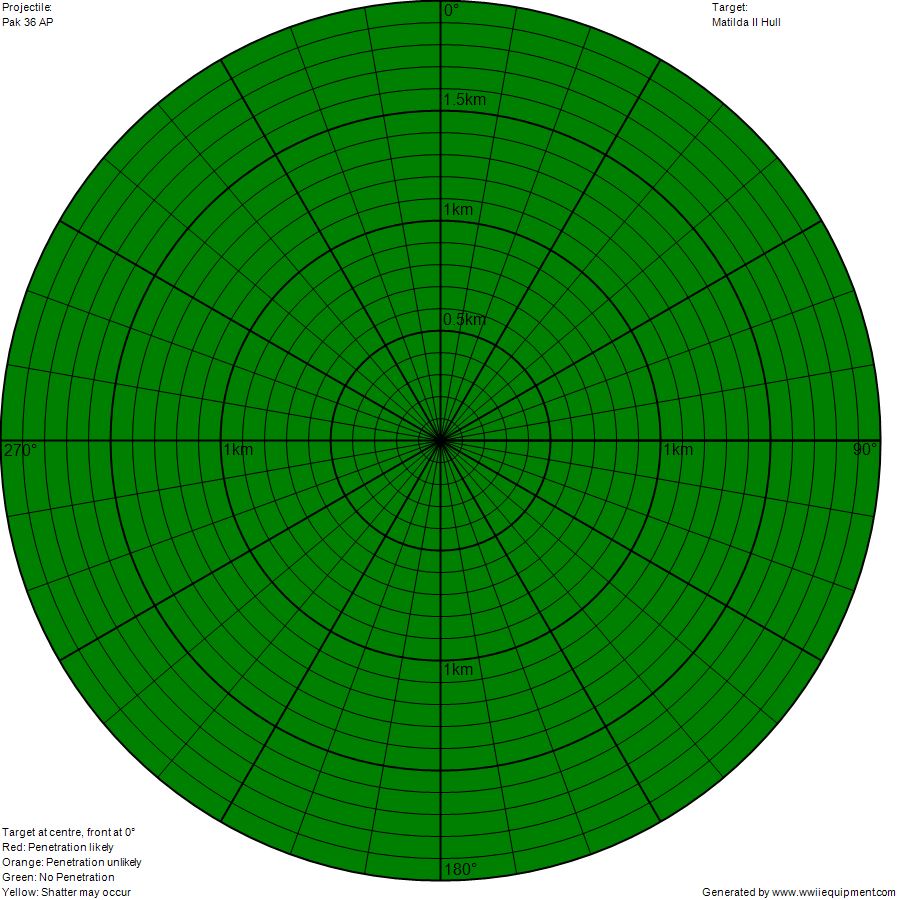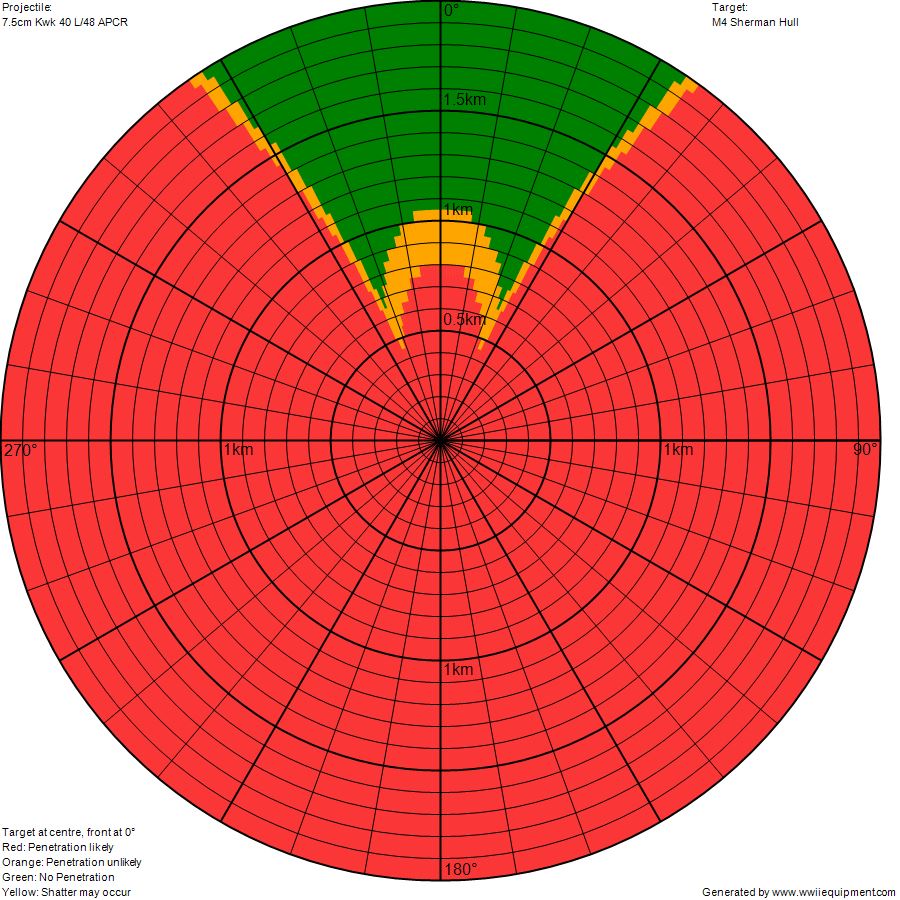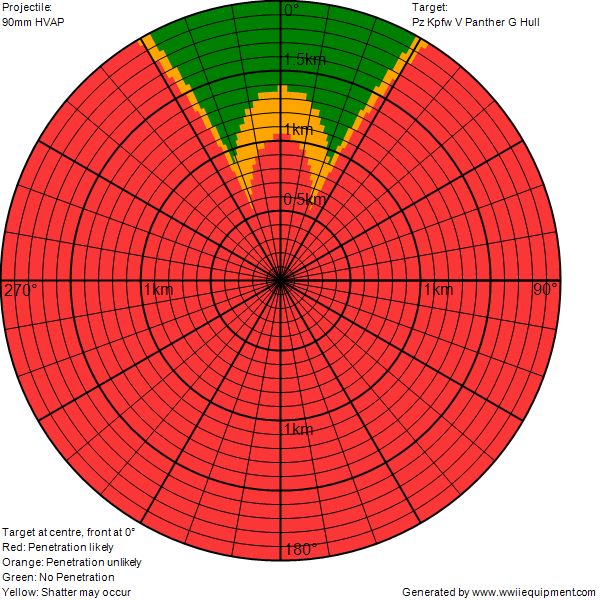Historically speaking, the Panther was germany's answer to the T-34. While the former was better armored and had a *slightly* better weapon, the T-34 had superior range and mobility. It's not as crass a difference as the game displays it.
The PzKw IV was ment as a support tank for the Stug III, mainly vs. Infantry and small Tanks like the T-70. The T-34 wtfpwned The Panzer IV so hard though, that the Germans developed the Panther. Later models of the PzIV (and those in the game) had a much better weapon. What is especially egregious, is that the T-34 can not reliably penetrate PzIV armor, while the PzIV can penetrate the T-34. That's so completely wrong, Stalin just turned over in his grave. Therefore, I think penetration of the T-34 should be upped considerably. That would also have the welcome side-effect of exciting T-34 vs. PzIV duels, instead of those lame stone-paper fights the current game pace provides.
The game has tank balance completely upside down. Balance is more important than realism is correct, but realism had balance as well, and - I am just leaning outside the window here - the leaders and engineers of the two biggest armies of the world did understand tank balance a tad better than relic does.
Please stop before I burst a gut laughing.
The Panther had a *slightly* better gun than the T-34? Does that mean that the T-34's 76mm F-34 gun was the equal of the german 88mm KwK 36 on the Tiger I? I'm asking because the Panther's 75mm KwK 42 was *slightly* better than the Tiger I's 88mm at armor penetration, and tended to be more accurate at long ranges, because the projectile travelled at greater speeds. The numbers are (normal ammo/special ammo, in m/s) 925-1000/1120 for the Kwk 42 on the Panther, compared to 800/930 for the KwK 36 on the Tiger I and 655-680/965 for the T-34's F-34 gun. Please note that the 88mm KwK 36 also had the higher caliber to its advantage (88mm compared to 75/76mm), and that should also be taken into consideration (basically, why the 75mm KwK 42 is only *slightly* better than the 88mm KwK 36), whereas the 1mm difference between the KwK 42 and the F-34 is largely irrelevant.
As for mobility and range, I'll just quote a soviet tanker from the era: "From the point of view of operating them, the German armoured machines were almost perfect, they broke down less often. For the Germans, covering 200 km was nothing, but with T-34s something would have been lost, something would have broken down. The technological equipment of their machines was better, the combat gear was worse.".
The Panther had an inauspicious (to say the least) start at Kursk, where the Ausf D version of the tank was used. Said Ausf D was pretty much a prototype version which the germans rushed to produce on Hitler's insistence especially for the Battle of Kursk. Trying to get as many Panthers on the ground delayed the start of the operation (Citadel) by over two months. The Ausf D were unreliable and broke down often, but the next variant, the Ausf A, came with improvements and by the time the Ausf G was rolling from the factory gates, the Panthers were some of the most reliable vehicles in the german army (and not only).
The only difference that is not as crass as the game displays it is the side/rear armor penetration. The T-34/76 did indeed have a decent chance of penetrating the Panther's side armor, even if only at (relatively) close ranges (say 500m). Other than that, the difference in armor and gun did indeed favor the Panther immensely.
Where did you get the idea that the Panzer IV was meant to back up the StuG III? This is plain wrong no matter how you look at it. The Panzer IV was initially meant to serve the role of infantry support, and mounted the short barrel 75mm KwK 37 gun. Right after the germans first encountered the T-34 and KV-1 soviet tanks, they rushed to upgrade the Panzer IV main gun to the 75mm KwK40 and bolt on 30mm more frontal armor for a combined total of 80mm frontal armor. The StuG III underwent the same treatment. The Panzer III, which started the war as the main tank killer of the german army, had the barrel of its 50mm gun made longer because it couldn't fit a 75mm KwK 40. Later on, it was upgraded to the 75mm KwK 37 (the same the Panzer IV started with) because it could fire HEAT rounds.
So, while essentially the Panzer IV did indeed start the war in an infantry support role, it quickly switched to anti-tank duties. The Panzer IV was NOT a support tank, it was pretty much the main battle tank of the german army for the duration of the war.
The StuG III, on the other hand, was the real support tank. It served in artillery battalions and was initially meant to fulfill the "direct-fire support role for infantry divisions". Later on, with the high velocity 75mm gun upgrade, it was increasingly used in a tank destroyer role, but kept its infantry support roots intact. Basically, you could say the StuG III was the do-it-all of the german army, staying close with infantry and providing fire support against both infantry (HE rounds), fortifications (HE rounds again) and enemy armor (there are several AT rounds, ranging from HEAT and APCBCHE to APCR). It excelled in a defensive role, as its low profile, good optics and good gun allowed it to snipe enemy tanks from a distance, while remaining concealed (which also had something to do with the gunpowder the germans were using, which produced less smoke).
Thing is, both Panzer IV and StuG III had the same armor thickness. That is 80mm front and 30mm sides/rear. The T-34/76 could only penetrate the front armor of Panzer IV/StuG III only at very close ranges. T-34/76 HEAT could not penetrate StuG III/Panzer IV frontal armor with HEAT ammo (only 75mm penetration). Firing APHE rounds would only penetrate 69mm at 500m, so the shot would probably need to be point blank to have any chance to penetrate the 80mm frontal armor. The only thing that could reliably penetrate Panzer IV/StuG III frontal armor was the APCR (tungsten core) special ammunition round, that could punch through 92mm of armor at 500m (so, it could probably go through the 80mm even at about 550-600m). But the APCR round was rare, it's not special ammunition for nothing. Even so, having to get as close as 600m to be effective with special ammunition against unsloped frontal armor does indeed mirror what is happening in CoH2, especially since the Panzer IV/StuG III could reliably take out the T-34/76 at far greater ranges.
I don't care how many times Stalin is turning in his grave. He probably wouldn't, he didn't really care how many soldiers lost their lives as long as the battle was won. To quote the results of american tests made on the T-34 during the war: "The earlier models of the T-34, until the Model 1942, had cast turrets whose armour was softer than that of the other parts of the tank, and offered poor resistance even to the 37 mm shells of automatic AA guns. The heavier German weapons could pierce the turret armour relatively easily.". This is probably why the Ostwind can inflict the damage it does, although it doesn't make too much sense (starting with 1943, T-34s had the new hexagonal turret which was supposed to be made from better materials and provide better protection).
Did the leaders and engineers of the two biggest armies in the world understand tank balance better than relic does? Maybe, maybe not. What should be done about the T-34/76 is as follows:
1. decrease the cost a bit, so it can be had in greater numbers. the cost is not that bad right now considering I've had situations in which I had to face two T-34/76 tanks with a single Panzer IV pretty early on (tried to get the Panzer IV rolling as soon as possible), but the cost is a bit high still. Perhaps increasing build times (for the building or the tanks) would be the answer here.
2. Make ramming a veteran ability. It makes much more sense than capturing points, but I guess the best way to go about this would be to enable ramming with the second level of veterancy.
3. Make ramming respect the laws of physics. The range for ramming should be decreased by 25% or so and have a maximum range once it is triggered (if it goes over this range, it should immediately stop and the driver should be stunned for a couple of seconds or something similar). Ramming should be susceptible to line of sight (how can you ram something you can't see?) and lateral movement. Steering a tank at high speed is a complicated affair and it can even damage the tracks (the tank can shed its tracks or break them rather easily). I've been in a situation where I was fighting two T-34/85 tanks with a Tiger and knowing that I'd get rammed as soon as I would get close to destroying one, I kept the Tiger at a distance. When the first T-34 engaged the ramming ability, I quickly backed the Tiger behind a thick pocket of trees (which blocked vision entirely) right after I popped smoke, and kept on driving backwards. To my everlasting surprise, T-34 came out of the smoke charging, took a 90 degree turn at full speed and was heading for the Tiger. I was lucky that the loading cycle was over and the Tiger destroyed the T-34 literally inches away. And then the second T-34 came out of the smoke charging, pulled the same stunt turn and rammed the Tiger. What. The. Hell.
4. Make the results of ramming more realistic. Why is the main gun destroyed for the tank that gets rammed? This happens even if said tank is targeting another vehicle. It should not happen. The rest (ramming tank gets its gun destroyed, probability of immobilization and degree of engine damage) seem fine as they are right now.
5. To make the T-34/76 better versus tanks, it should be able to purchase special ammunition (the Armor Piercing Composite Rigid with tungsten core) that only ever gets used against medium and heavy tanks (by default). It should have increased damage (say 100 instead of 80), have a decent chance of penetrating Panzer IV, StuG III and Ostwind frontal armor, cost about 20 ammo per unit (projectile) and each tank should be able to stack a maximum of 4-5. Can resupply (purchase more) at base, near halftracks and ammo dumps built over strategic points. This should be in line with reality and should make everyone happy with the T-34/76's AT capabilities.
6. Make side armor a bit weaker overall (for both germans and soviets). The T-34/76 should be able to punch through Panzer IV/StuG III/Ostwind side armor somewhat reliably, at least closer ranges.
7. Availability. Make the T-34/85 available through the T4 soviet building. These tanks were widely available to the Red Army. The SU-85 wasn't so readily available by a long shot. Replacing the T-34/85 with the SU-85 in the doctrine (and vice-versa for the T4 building) is one way to go about things. Another is to simply add T-34/85 to the T4 soviet building, keep it in the doctrine in a changed state (instantly call two T-34/85s at 75% the cost each, add a long reload time) and decrease the SU-85 extended range and speed, slightly decreasing accuracy while increasing reload times for extended range shots. This would keep the doctrine interesting, give the soviet players a more balanced and versatile T4 way of going about things.
















 .
.






 cblanco ★
cblanco ★  보드카 중대
보드카 중대  VonManteuffel
VonManteuffel  Heartless Jäger
Heartless Jäger 